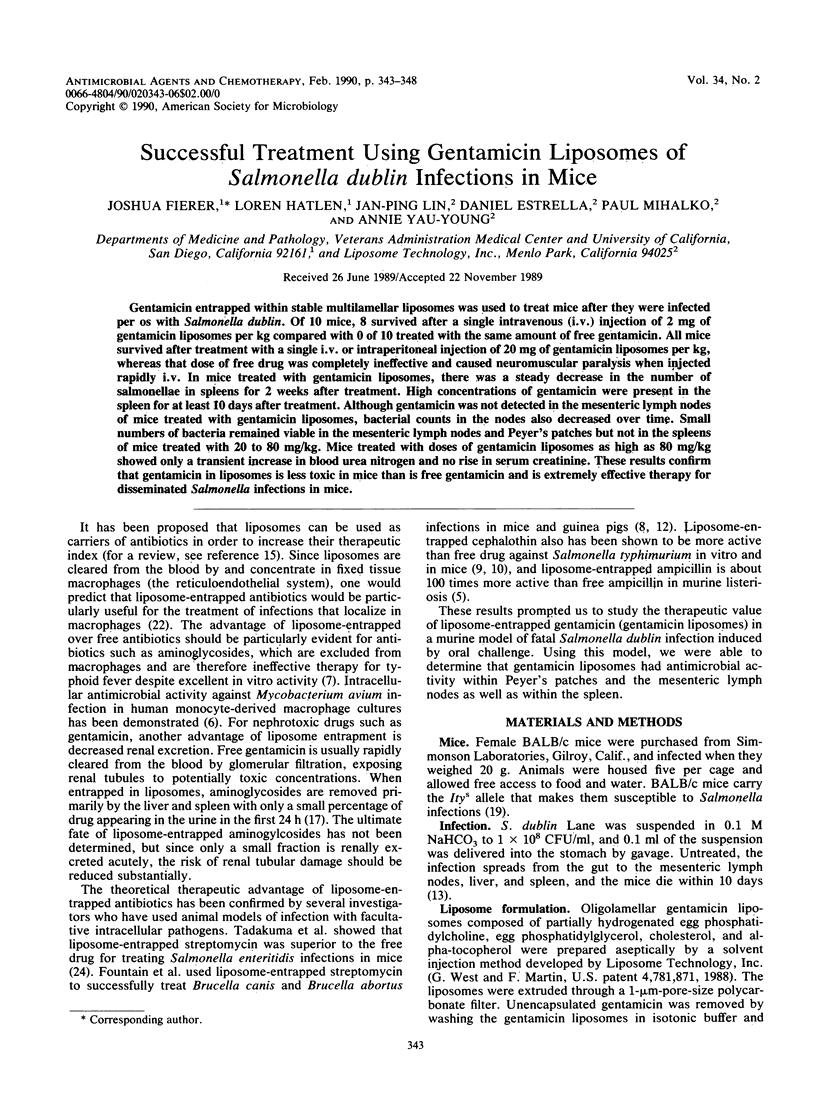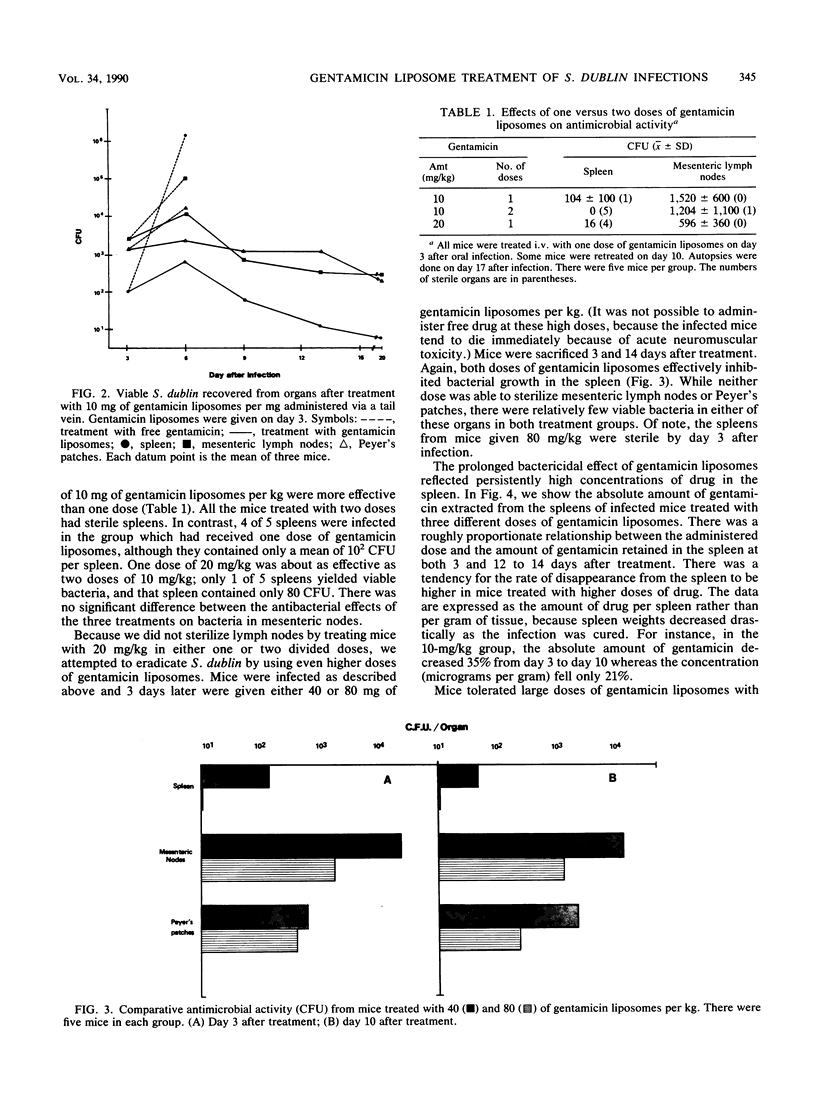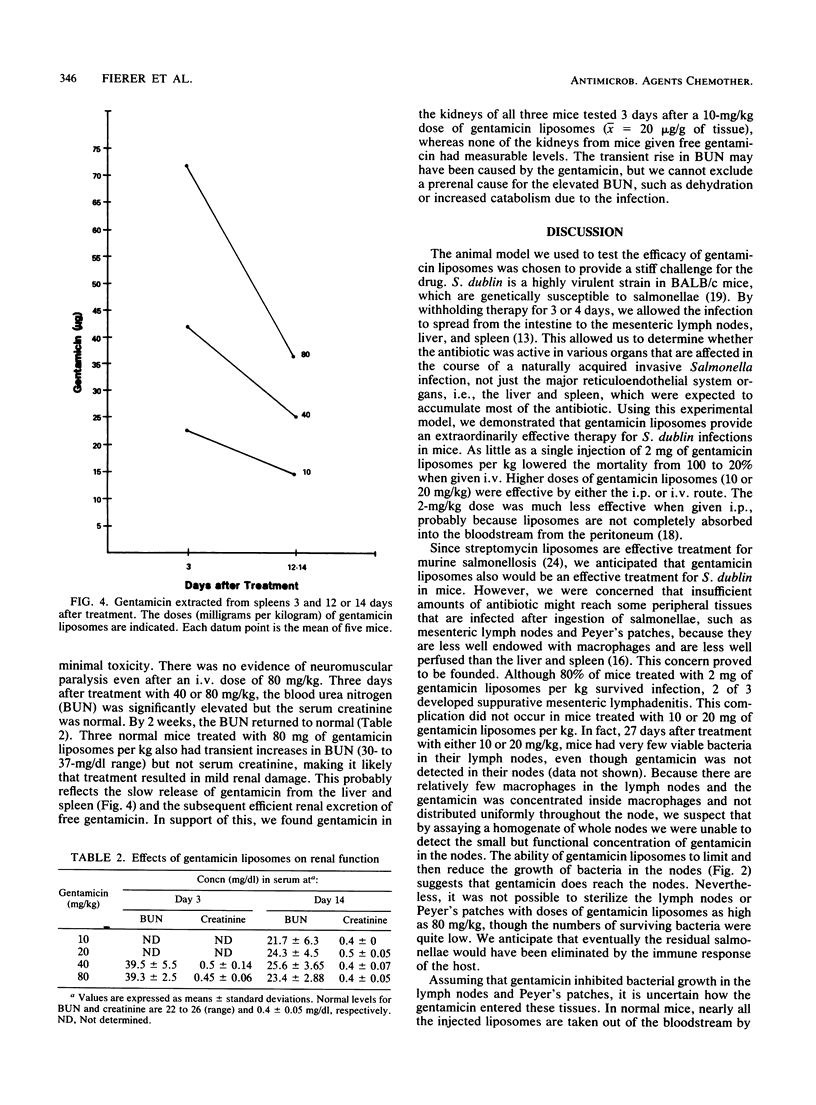Abstract
Gentamicin entrapped within stable multilamellar liposomes was used to treat mice after they were infected per os with Salmonella dublin. Of 10 mice, 8 survived after a single intravenous (i.v.) injection of 2 mg of gentamicin liposomes per kg compared with 0 of 10 treated with the same amount of free gentamicin. All mice survived after treatment with a single i.v. or intraperitoneal injection of 20 mg of gentamicin liposomes per kg, whereas that dose of free drug was completely ineffective and caused neuromuscular paralysis when injected rapidly i.v. In mice treated with gentamicin liposomes, there was a steady decrease in the number of salmonellae in spleens for 2 weeks after treatment. High concentrations of gentamicin were present in the spleen for at least 10 days after treatment. Although gentamicin was not detected in the mesenteric lymph nodes of mice treated with gentamicin liposomes, bacterial counts in the nodes also decreased over time. Small numbers of bacteria remained viable in the mesenteric lymph nodes and Peyer's patches but not in the spleens of mice treated with 20 to 80 mg/kg. Mice treated with doses of gentamicin liposomes as high as 80 mg/kg showed only a transient increase in blood urea nitrogen and no rise in serum creatinine. These results confirm that gentamicin in liposomes is less toxic in mice than is free gentamicin and is extremely effective therapy for disseminated Salmonella infections in mice.
Full text
PDF





Images in this article
Selected References
These references are in PubMed. This may not be the complete list of references from this article.
- Allen T. M., Murray L., MacKeigan S., Shah M. Chronic liposome administration in mice: effects on reticuloendothelial function and tissue distribution. J Pharmacol Exp Ther. 1984 Apr;229(1):267–275. [PubMed] [Google Scholar]
- Allen T. M., Smuckler E. A. Liver pathology accompanying chronic liposome administration in mouse. Res Commun Chem Pathol Pharmacol. 1985 Nov;50(2):281–290. [PubMed] [Google Scholar]
- Alving C. R. Delivery of liposome-encapsulated drugs to macrophages. Pharmacol Ther. 1983;22(3):407–424. doi: 10.1016/0163-7258(83)90010-4. [DOI] [PubMed] [Google Scholar]
- Appel G. B., Neu H. C. Gentamicin in 1978. Ann Intern Med. 1978 Oct;89(4):528–538. doi: 10.7326/0003-4819-89-4-528. [DOI] [PubMed] [Google Scholar]
- Bakker-Woudenberg I. A., Lokerse A. F., Roerdink F. H., Regts D., Michel M. F. Free versus liposome-entrapped ampicillin in treatment of infection due to Listeria monocytogenes in normal and athymic (nude) mice. J Infect Dis. 1985 May;151(5):917–924. doi: 10.1093/infdis/151.5.917. [DOI] [PubMed] [Google Scholar]
- Bermudez L. E., Wu M., Young L. S. Intracellular killing of Mycobacterium avium complex by rifapentine and liposome-encapsulated amikacin. J Infect Dis. 1987 Sep;156(3):510–513. doi: 10.1093/infdis/156.3.510. [DOI] [PubMed] [Google Scholar]
- Dees C., Fountain M. W., Taylor J. R., Schultz R. D. Enhanced intraphagocytic killing of Brucella abortus in bovine mononuclear cells by liposomes-containing gentamicin. Vet Immunol Immunopathol. 1985 Jan;8(1-2):171–182. doi: 10.1016/0165-2427(85)90120-5. [DOI] [PubMed] [Google Scholar]
- Desiderio J. V., Campbell S. G. Intraphagocytic killing of Salmonella typhimurium by liposome-encapsulated cephalothin. J Infect Dis. 1983 Sep;148(3):563–570. doi: 10.1093/infdis/148.3.563. [DOI] [PubMed] [Google Scholar]
- Desiderio J. V., Campbell S. G. Liposome-encapsulated cephalothin in the treatment of experimental murine salmonellosis. J Reticuloendothel Soc. 1983 Oct;34(4):279–287. [PubMed] [Google Scholar]
- Dijkstra J., van Galen M., Regts D., Scherphof G. Uptake and processing of liposomal phospholipids by Kupffer cells in vitro. Eur J Biochem. 1985 Apr 15;148(2):391–397. doi: 10.1111/j.1432-1033.1985.tb08851.x. [DOI] [PubMed] [Google Scholar]
- Fountain M. W., Weiss S. J., Fountain A. G., Shen A., Lenk R. P. Treatment of Brucella canis and Brucella abortus in vitro and in vivo by stable plurilamellar vesicle-encapsulated aminoglycosides. J Infect Dis. 1985 Sep;152(3):529–535. doi: 10.1093/infdis/152.3.529. [DOI] [PubMed] [Google Scholar]
- Heffernan E. J., Fierer J., Chikami G., Guiney D. Natural history of oral Salmonella dublin infection in BALB/c mice: effect of an 80-kilobase-pair plasmid on virulence. J Infect Dis. 1987 Jun;155(6):1254–1259. doi: 10.1093/infdis/155.6.1254. [DOI] [PubMed] [Google Scholar]
- Hostetler K. Y., Hall L. B. Inhibition of kidney lysosomal phospholipases A and C by aminoglycoside antibiotics: possible mechanism of aminoglycoside toxicity. Proc Natl Acad Sci U S A. 1982 Mar;79(5):1663–1667. doi: 10.1073/pnas.79.5.1663. [DOI] [PMC free article] [PubMed] [Google Scholar]
- Lopez-Berestein G. Liposomes as carriers of antimicrobial agents. Antimicrob Agents Chemother. 1987 May;31(5):675–678. doi: 10.1128/aac.31.5.675. [DOI] [PMC free article] [PubMed] [Google Scholar]
- MacDonald T. T., Carter P. B. Isolation and functional characteristics of adherent phagocytic cells from mouse Peyer's patches. Immunology. 1982 Apr;45(4):769–774. [PMC free article] [PubMed] [Google Scholar]
- Morgan J. R., Williams K. E. Preparation and properties of liposome-associated gentamicin. Antimicrob Agents Chemother. 1980 Apr;17(4):544–548. doi: 10.1128/aac.17.4.544. [DOI] [PMC free article] [PubMed] [Google Scholar]
- Parker R. J., Hartman K. D., Sieber S. M. Lymphatic absorption and tissue disposition of liposome-entrapped [14C]adriamycin following intraperitoneal administration to rats. Cancer Res. 1981 Apr;41(4):1311–1317. [PubMed] [Google Scholar]
- Poste G., Bucana C., Raz A., Bugelski P., Kirsh R., Fidler I. J. Analysis of the fate of systemically administered liposomes and implications for their use in drug delivery. Cancer Res. 1982 Apr;42(4):1412–1422. [PubMed] [Google Scholar]
- Raz A., Bucana C., Fogler W. E., Poste G., Fidler I. J. Biochemical, morphological, and ultrastructural studies on the uptake of liposomes by murine macrophages. Cancer Res. 1981 Feb;41(2):487–494. [PubMed] [Google Scholar]
- Schroit A. J., Hart I. R., Madsen J., Fidler I. J. Selective delivery of drugs encapsulated in liposomes: natural targeting to macrophages involved in various disease states. J Biol Response Mod. 1983;2(2):97–100. [PubMed] [Google Scholar]
- Straubinger R. M., Hong K., Friend D. S., Papahadjopoulos D. Endocytosis of liposomes and intracellular fate of encapsulated molecules: encounter with a low pH compartment after internalization in coated vesicles. Cell. 1983 Apr;32(4):1069–1079. doi: 10.1016/0092-8674(83)90291-x. [DOI] [PubMed] [Google Scholar]
- Tadakuma T., Ikewaki N., Yasuda T., Tsutsumi M., Saito S., Saito K. Treatment of experimental salmonellosis in mice with streptomycin entrapped in liposomes. Antimicrob Agents Chemother. 1985 Jul;28(1):28–32. doi: 10.1128/aac.28.1.28. [DOI] [PMC free article] [PubMed] [Google Scholar]



